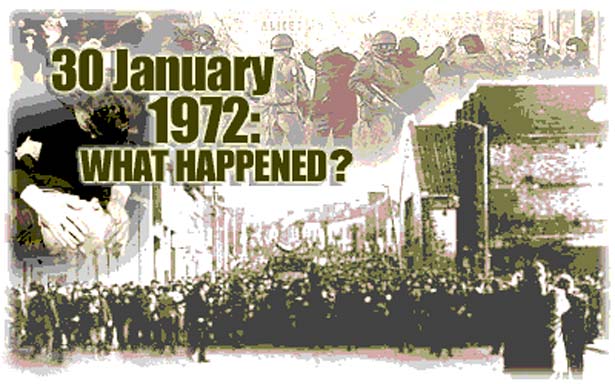Introduzione
Il 30 gennaio 1972, 13 cattolici furono assassinati quando i soldati di un reggimento di paracadutisti dell’esercito britannico aprirono il fuoco durante una marcia per i diritti civili a Derry. Una quattordicesima vittima morì qualche mese dopo per le ferite riportate quel giorno. Il giorno divenne famoso come Bloody Sunday. Il suo impatto portò alla rinascita di una violenta opposizione delle presenza britannica nel Nord dell’Irlanda. Sebbene molti dettagli rimangono controversi, molti dei fatti non sono opinabili.
14.50: La marcia inizia
La dimostrazione di protesta è svolta contro la politica dell’internamento senza processo. Fu organizzata dalla Northern Ireland Civil Rights Association (Associazione per i Diritti Civili in Irlanda del Nord). Quasi 10.000 persone si radunano nel quartiere di Creggan, con l’intenzione di marciare verso la Guildhall Square (la piazza del municipio) nel centro della città, dove si terrà un raduno. La marcia stessa era illegale perché il parlamento di Stormont ha vietato tutte le proteste.
15.40: Confronto
I paracadutisti hanno isolato gli accessi alla Guildhall Square. Per evitare disordini, gli organizzatori guidano la maggior parte dei dimostranti lungo Rossville Street verso il Free Derry Corner. Un gruppo di contestatori resta indietro per confrontarsi con i soldati alle barricate. Pietre ed altri oggtti sono utilizzati per colpire i soldati, che rispondono sparando proiettili di gomma, gas lacrimogeno e usando un cannone ad acqua. Il gas obbliga molti dei partecipanti a trovare rifugio nel Bogside.
16.10: I soldati aprono il fuoco
I paracadutisti hanno l’ordine di muoversi ed arrestare il più alto numero di partecipanti possibile. Avanzano lungo Rossville Street fin dentro al Bogside. Ciò che accade subito dopo non è chiaro. Il soldati dicono essere finiti sotto attacco dalle case di Rossville mentre entrano per eseguire gli arresti e di aver risposto al fuoco. La comunità cattolica afferma che i soldati sul terreno e i cecchini dell’esercito posizionati sulle mura cittadine sopra al Bogside hanno aperto il fuoco contro i civili disarmati.
16.40: Tredici morti
Dopo 25 minuti di spari, 13 partecipanti alla marcia sono morti. Un’inchiesta di Lord Widgery riporta che gli spari dei paracadutisti sono “al limite della sconsideratezza”. Concluse che i soldati avevano aperto il fuoco per primi e che alcune delle vittime avevano impugnato armi. La comunità cattolica respinse quelle conclusioni e cominciò una lunga campagna per un’altra inchiesta. Nel 1998 fu annunciata l’istituzione di una nuova inchiesta sugli eventi del Bloody Sunday, guidata da Lord Saville.
Tratto da BBC News
Bloody Sunday, Derry 30th January 1972
Introduction
On 30th January 1972, 13 Catholics were killed when soldiers of a British paratroop regiment opened fire during a civil rights march in Londonderry. The day became known as Bloody Sunday. Its impact led to a resurgence of violent opposition to the British presence in Northern Ireland. Although the details of what took place that day remain controversial, many of the basic facts are not disputed.
1450: The march begins
The demonstration was held in protest at the policy of internment without trial. It was organised by the Northern Ireland Civil Rights Association. About 10,000 people gathered in the Creggan Estate planning to walk to Guildhall Square in the centre of the city, where a rally would be held. The march itself was illegal because the Stormont Parliament had banned all such protests.
1540: Confrontation
Paratroopers had sealed off the approaches to Guildhall square. In order to avoid trouble the march organisers led most of the demonstrators down Rossville Street towards Free Derry Corner. A group of protesters stayed behind to confront the soldiers at the barricades. Stones and other missiles were used to bombard the soldiers who responded with rubber bullets, CS gas and a water cannon. The gas forced many of the remaining protesters to take refuge in the Bogside.
1610: Soldiers open fire
The paratroopers had orders to move in and arrest as many of the civil rights marchers as possible. They advanced down Rossville Street into the Bogside. What exactly happened next is not clear. The soldiers say they were fired upon from the Rossville flats as they moved in to make arrests and that they returned fire. The Catholic community says soldiers on the ground and army snipers on the city walls above the Bogside shot unarmed civilians.
1640: Thirteen dead
After 25 minutes of shooting, 13 civil rights marchers were dead. An inquiry by Lord Widgery reported that the paratroopers’ firing had “bordered on the reckless”. It also concluded the soldiers had been fired upon first and some of the victims had handled weapons. The Catholic community rejected these findings and began the long campaign for another inquiry. In 1998 a fresh inquiry into the events of Bloody Sunday was announced.
